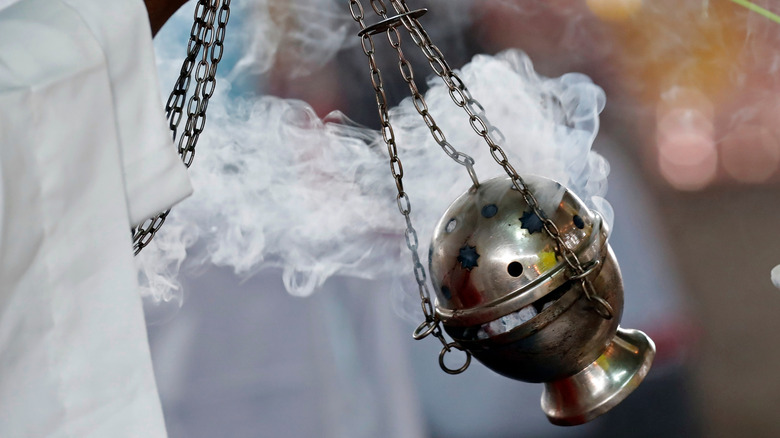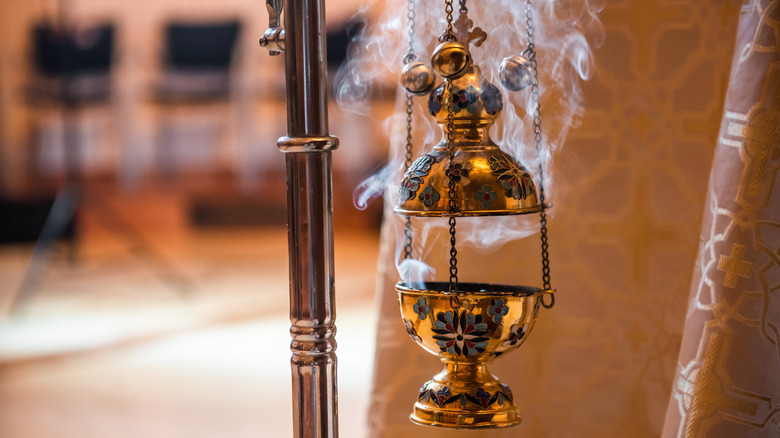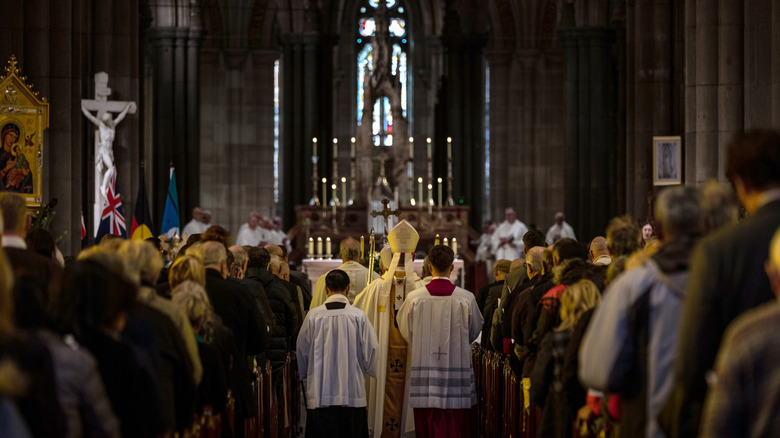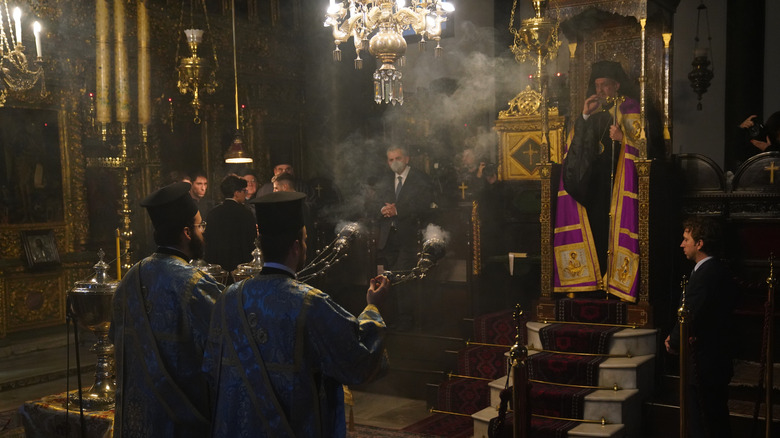What It Means When A Priest Swings Incense Around A Casket
Folks who've attended certain Catholic Masses and rituals no doubt remember the sweet scent of myrrh and frankincense — two of the biblical gifts given by the three wise men to the baby Jesus in the Nativity story. Or at least, those are the two fragrances most often swung around in censers (pronounced "sensors"), aka thuribles. It might have seemed odd, and maybe even a little distracting, to see a priest swing around this sweet-scented, fuming metal pot thing — like a vision of some ancient and arcane rite with a purpose long-forgotten. Ancient and arcane might be correct, but not long-forgotten. Because if a priest of either Roman Catholic or Eastern Orthodox variety swings a censer around at a service, especially of the funereal variety, then it means one basic thing: The scent bridges the earthly and the divine.
The use of incense and beautiful scents in sacred rites isn't exactly limited to Judeo-Christian traditions, either. Humanity has long-connected not only luxurious smells but also smoke and fumes in general with holy or ecstatic experiences. Native Americans of numerous tribes and spiritual practitioners of all stripes have used sage smudges, for example, to cleanse and purify. Non-Western religious practices like Hinduism and Buddhism are absolutely replete with incense for this same purpose, as well as to alter consciousness and invoke a sense of reverence.
Ancient Jewish practices also involved incense, per God's commandments to Moses. And of course, the Bible's Old and New Testaments are full of references linking the Lord with holy smells. A priest's use of a censer connects to this entire heritage, and it takes on a poignant note at a funeral marking the dead's return to God.
Invoking the scents of paradise
Even though we moderns are greatly removed from the original purpose behind many religious rituals, ritualistic meaning often lingers. Anytime someone nowadays does aromatherapy or lights incense to "purify" the air or some such thing, that person is adhering to the same basic principle as a priest with a censor at a Roman Catholic or Eastern Orthodox service. The same goes for non-Christian beliefs, as mentioned. But in the Western vein, the use of incense to call upon the gods goes back to the same root as most other things: ancient Greece and Rome.
Though substances vary, we know that Minoans and Mycenaeans in the Aegean Sea going back to at least 3000 B.C.E. harvested saffron, ladanum, brazilwood, turnsole, and more for ritualistic use. Neighboring Assyrians used local flora convenient to them, like cedar, cypress, and juniper. Greek and then Roman temples to the gods were full of scents deemed divine. Roman funerals of the more expensive variety, for example, used cinnamon, while less expensive spices were used if the deceased's family couldn't afford something more opulent.
When the Roman Emperor Constantine converted to Christianity in 312 C.E., he indirectly permitted the adoption of such pre-Christian practices at Christian rituals. He donated some censers to a church in Rome to make the place smell better, and the church on a whole incorporated, bit by bit, incense into services. And when the Western Roman empire fell in 476 C.E., the eastern half centered at Constantinople — named after Constantine — carried on. The church there developed into the Eastern Orthodox Church, which also uses censers to invoke the scents of paradise.
Using a censer at a funeral and otherwise
The use of incense at funerals first crops up in the early, 2nd-century C.E. Christian church, pre-Constantine. It took until 1350 C.E. — over 1,000 years — for all of the rules regarding censers to cohere. In the early church, incense was typically reserved for the funerals of martyrs and later to the dedication of churches. But in the present, funerals afford the most flexible use of censers. As the EWTN explains, the church adheres to a "universal and logical criterion" regarding using censers at funerals, one that can "defer to local custom with respect to many details." But no matter what, the basic meaning is clear: To honor the dead, honor God, and sanctify a space.
At this point, there are loads of highly prescriptive rules regarding when, where, and how censers and incense can be used during church services. The Vatican's General Instruction of the Roman Missal, section 276 (titled "Incensation"), cites the biblical books of Psalms and Revelation to state that incense may be used during any kind of mass. Specifically, it can be used during the Entrance procession, at the beginning of Mass, during the Gospel procession and proclamation, and more. There are reams of other stipulations regarding bowing, giving blessings, the amount of times the censer can be swung and in what direction, how the priest walks while doing this (especially in relation to the surrounding architecture), how many scoops of incense to use, etc. Knowing this, the reader will likely never again think that a priest is just randomly swinging around a smoking metal pot.
Roman Catholic and Eastern Orthodox differences
We already mentioned the Roman Catholic and Eastern Orthodox divide, but it pays to go a bit deeper to cover all ground regarding censers, incense, and funerals. In some respects, the differences between Western and Eastern might seem incredibly minor to non-believers, like Western Christianity (including Protestantism) using unleavened bread and Eastern using leavened. Eastern priests can also marry, unlike Western ones. Then there are disagreements about big topics like the nature of the Trinity and the use of icons. And in general, Eastern Orthodox services and churches are saturated in decoration, symbolism, color, scents, full of icons and iconography, and come across as way more mystical than Roman Catholicism. Incense, specifically, is a symbol of prayer rising to God.
But when it comes to the use of censers at funerals, Eastern Orthodoxy is more or less the same as Roman Catholicism in essence, but more prescriptive in practice. As Everplans outlines, a priest leads a procession to and around the casket and "censes" (as a verb) the deceased and the people in attendance. There are traditional hymns involved and a procedure for opening the casket. There's also a candle and bowl of boiled wheat and honey placed at the head of the casket, among other things. And then there are differences between the Eastern Orthodox Church on a whole and the Greek Orthodox Church, which is a subset of the Eastern Orthodox Church. But now matter what, all uses of censers at funerals denote the same fundaments of reverence, respect, and linking a set of earthly rituals to the divine.



